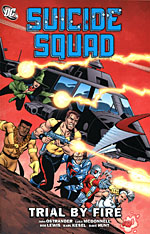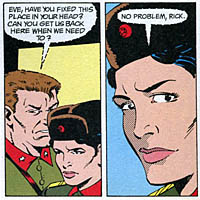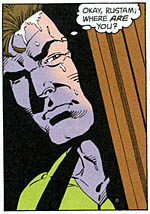 Written by John Ostrander
Written by John Ostrander
Penciled by Luke McDonnell
Inked by Bob Lewis, Karl Kesel, and Dave Hunt
232 pages, color
Published by DC Comics
Once a year or so, when I’m looking at comics, I’ll find myself wondering why there currently isn’t an ongoing (and wildly successful) Suicide Squad series, preferably written by John Ostrander. It’s a simple but easy to understand premise (a government black ops team, partially staffed by criminals in exchange for lesser sentences), and the possibility for different characters to appear left and right is fairly limitless. Hopefully this long-awaited first volume of Suicide Squad reprints will drum up some interest, because a strong revival is long overdue.
I haven’t read my copies of Suicide Squad in well over a decade, but I was surprised at how well the comic still held up. This initial volume reprints Suicide Squad #1-8 plus an introduction in the form of Secret Origins #14. It’s that last one (which opens the collection) that I’d never read before, and it’s almost a shame that it’s the first story in the book because it’s also the weakest. It’s a history of the Squad, explaining how it came out and also the life story of its commander, Rick Flag. It’s an unusually dry opening story, perhaps because so much of it is a summary of older comics from three decades earlier. (It is slightly amusing that after so much time spent on the earlier incarnation of the team and Rick Flag’s life, the modern Squad’s first appearance in the big mini-series Legends is summarized in one page.) Once that’s done, though, Ostrander hits the ground running and never looks back.
 Part of the appeal of Suicide Squad is that Ostrander’s "playground" is mammoth. From stopping the terrorist cult Kobra, to a trip beyond the Iron Curtain to rescue a political dissident (after all, this was published during the Cold War), and even an appearance by Darkseid’s Female Furies from Apokolips, Ostrander is able to use all sorts of different settings and threats to keep the book lively and interesting. That large playground also includes a huge pool of potential characters to appear in the book; essentially, any super-villain who wasn’t actively appearing elsewhere. And true to the name of the book, there’s the continual threat of characters not coming back from a mission to keep the readers guessing. A book about a black ops would get unbelievable if they all made it through each mission in perfect health.
Part of the appeal of Suicide Squad is that Ostrander’s "playground" is mammoth. From stopping the terrorist cult Kobra, to a trip beyond the Iron Curtain to rescue a political dissident (after all, this was published during the Cold War), and even an appearance by Darkseid’s Female Furies from Apokolips, Ostrander is able to use all sorts of different settings and threats to keep the book lively and interesting. That large playground also includes a huge pool of potential characters to appear in the book; essentially, any super-villain who wasn’t actively appearing elsewhere. And true to the name of the book, there’s the continual threat of characters not coming back from a mission to keep the readers guessing. A book about a black ops would get unbelievable if they all made it through each mission in perfect health.
The choice of characters used for Suicide Squad goes a long way. Ostrander has a code group immediately established—Rick Flag, Bronze Tiger, Deadshot, Captain Boomerang, Enchantress, Nightshade, and Nemesis—and then supplements them with additional faces chosen to be useful to the mission. It’s a smart tactic; having a complete turnover on each mission (one of the mistakes made with Keith Giffen’s short-lived revival ten years ago) means a lack of caring on the part of the reader for the team. Here, you quickly develop favorites, while a fun group of extras pad out the roster. Ostrander gives a lot of attention in this first volume to the character of the Enchantress, with a Jekyll-and-Hyde issue regarding her powers. It’s easy to feel sympathy for June (the good, non-powered half) as she struggles to control the Enchantress, and Ostrander quickly has the readers understand that the character is a ticking time bomb, and an eventual betrayal is best not described with an if, but a when. Other characters like Deadshot and Captain Boomerang are also quickly getting their personalities established that would carry them into fan favorites, even as Nightshade and Nemesis serve to remind the reader that for genuine good people on board this is a dangerous and slightly unpleasant job.
And of course, Suicide Squad gives us Amanda Waller, the bureaucrat in charge of the team. Here it’s easy to see why "the Wall" became such a popular and long-lasting character. The first glimmers of ruthlessness are already beginning to appear here, and her spotlight in the reprint of Secret Origins helps to show us how this is a woman who will not only rise up from adversity to get stronger, but that there’s nothing she won’t achieve when she puts her mind to it. For a character that doesn’t go on missions as an active member, it’s impressive how much of a central piece of the book Waller becomes. It helps that Ostrander regularly focuses on the lives of the people that make up the Squad in a series of stories titled "Personal Files." The first one closes out Suicide Squad: Trial by Fire, and it’s probably one of the best parts of this first book. Ostrander shows us what they do when not on missions, and makes this group more than just a bunch of names and costumes. It makes you want to cheer (or boo) them all on, and makes their upcoming victories and defeats that much more important.
 The book is penciled by Luke McDonnell, whose art is fine but ultimately nothing special. It’s in many ways the epitome of mid-’80s superhero comic art; clean lines, solid page layouts, good but not very memorable character designs. To be fair, most of the characters already had looks that were inherited from other comics, but none the less it’s a very average looking comic. Still, it’s easy to follow, and I never felt from start to finish like the art was working against the story; it’s just that McDonnell’s art will also never turn your head. It’s dependable and there’s nothing wrong with it, so that certainly rises it a head and shoulders above many other artists in the industry at that time.
The book is penciled by Luke McDonnell, whose art is fine but ultimately nothing special. It’s in many ways the epitome of mid-’80s superhero comic art; clean lines, solid page layouts, good but not very memorable character designs. To be fair, most of the characters already had looks that were inherited from other comics, but none the less it’s a very average looking comic. Still, it’s easy to follow, and I never felt from start to finish like the art was working against the story; it’s just that McDonnell’s art will also never turn your head. It’s dependable and there’s nothing wrong with it, so that certainly rises it a head and shoulders above many other artists in the industry at that time.
This reprint has been a long time coming (DC Comics twice solicited and then cancelled a Showcase Presents edition of the book), but it genuinely was worth the wait. With a second collection scheduled for this fall, it gives me hope that some day I’ll be able to have a bookshelf full of Suicide Squad collections. Knowing the best is yet to come (especially once the late, great Kim Yale officially steps on board as co-writer) makes me that much more eager. These days books like Secret Six are definitely taking their lead from territory that Suicide Squad tread earlier; this comic was always slightly ahead of its time. If you’ve never tried Suicide Squad before, you’ve got a lot of great reading up ahead. I can’t wait for the next volume. More, please.
Purchase Links: Amazon.com | Powell’s Books
